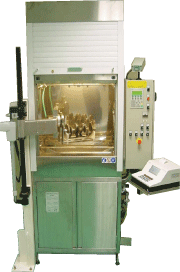E-Archive
Articles
in Vol. 12 - September Issue - Year 2011
Controlling Cleaning and Bath Quality. Reliably Clean?

Automated microscopy with image processing examines the analysis filter

Since particles cannot be substantiated directly on the surface of the majority of the components under test due to their geometry, a cleaning step is required which washes particles into a liquid medium. This is usually carried out in special cleanliness cabinets. Image Source: Pall Corporation

Cleaning agent concentration can be continuously ascertained and monitored on the basis of highly precise measurements of absolute sound propagation velocity and process temperature with this system. Image source: SensoTech

Control unit for a system for fully automated monitoring of bath quality and cleaning agent concentration, as well as consumption-dependent, additional dosing of builders and tensides. Image source: SITA Messtechnik
Neuffen – The quality and reliability of components during actual use after the production process depend just as decisively on work piece cleanliness as do the results of downstream processes. Parts2clean informs visitors about various methods of efficiently controlling the cleanliness of cleaned parts and surfaces, as well as the performance of cleaning baths, in a requirement-oriented manner. The leading international trade fair for industrial parts and surface cleaning will take place at the Stuttgart Exhibition Centre from the 25th through the 27th of October, 2011.
Residues which are deposited on work piece surfaces during manufacturing and machining processes, for example particles, burrs and dust as well as oil, emulsions and separating agents, are unavoidable. In order to assure that this contamination neither has a negative impact on the results of subsequent processes such as coating, hardening, welding and bonding nor impairs the function of components during later use, degrees of cleanliness which are matched to actual requirements have to be achieved by the cleaning process. In many industry sectors, the achieved degree of cleanliness has to be monitored and documented as well. "Continuous monitoring of cleaning and rinsing baths is also becoming more and more important, because this has a significant influence on operating costs for the cleaning process", reports Hartmut Herdin, managing director of fairXperts GmbH, promoters of parts2clean.
Pinpointing and Analysing Particles
With regard to inspection for determining whether or not particulate cleanliness specifications have been complied with, the automotive industry has created a standard reference work, namely VDA volume 19, "Technical Cleanliness Testing – particulate contamination of function-relevant automobile components", and its international counterpart, i.e. ISO 16232, Volumes 1 through 10, "Road vehicles – Cleanliness of components of fluid circuits". The objective of these directives is to be able to evaluate and compare the technical cleanliness of a part by means of clear-cut, unambiguously described procedures for extracting and analysing particulate contamination from production and the environment. In the meantime, VDA 19 is generating great interest in numerous industries, for example medical technology and precision engineering, as well as the optics and hydraulics industries.
Exhibitors at parts2clean will present various systems for conducting cleanliness analyses in accordance with VDA 19 / ISO 16232. Amongst others, these include extraction modules which are used for a variety of particle extraction methods. Where subsequent evaluation of particles retained in the filter is concerned, offerings range from laboratory scales for gravimetric determination, particle scanners and optical microscopes, right on up to scanning electron microscopes and micro-tomographs. Equipment manufacturers offer systems which have been specially designed for the automated analysis of residual contamination filters. As a rule, these can be adapted to individual factory standards.
Companies for whom it doesn’t pay to have their own cleanliness inspection equipment or who do not have the necessary personnel, can take advantage of experienced, certified service providers.
The use of fluid particle counters, for example extinction particle counters, eliminates the need for analysis filters which are required for gravimetry and microscopy. As a prerequisite for reliable results, the test fluid may not contain any gas bubbles or droplets of extraneous liquids during measurement.
Tracking Down Film-Like Contamination
If residues from processing media remain on work piece surfaces after cleaning, the quality of results obtained from downstream processes such as coating, painting, bonding, hardening and welding may be impaired. Various test methods are available for tracking these residues down. The simplest are test inks. Inline systems are available as well. These function on the basis of various processes, for example relative change in luminance which results from thin layers on surfaces, or laser-induced, time-resolved fluorescence spectroscopy. Beyond this, the exhibition programme includes systems for contact angle measurement as well, which are also available as portable instruments.
Monitoring Cleaning and Rinsing Baths
Changing the bath too early results in unnecessary costs. If cleaning and rising baths are changed too late, cleaning quality suffers and costly rework results. Bath monitoring and media conditioning are thus important factors in quality and cost-optimised manufacturing processes. Various systems are available for continuous monitoring of cleaning baths. Offerings include manual measuring instruments, as well as fully automated systems. The latter ascertain actually available cleaning power during the running process and automatically add cleaning agent depending upon consumption, or indicate the need for a bath change before it’s too late.
In addition to information offered by the exhibitors, the parts2clean expert forum, held in German, provides lots of know-how regarding analysis procedures and the issue of technical cleanliness. Further information and a preliminary exhibitor list are available at www.parts2clean.com.
For Information:
Rita Herdin, fairXperts GmbH
Hauptstrasse 7, 72639 Neuffen, Germany
Tel. +49.7025.8434-0
Fax +49.7025.8434-20
E-mail: info@fairxperts.de
www.fairxperts.de




























